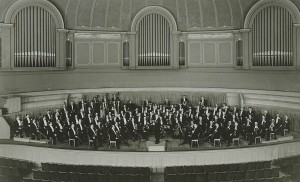Let’s take a careful look at an upcoming audition in Montreal and consider what an audition committee may (or may not) be looking for in when listening to an applicant. Trust me when I say that I’ve served on many.
Firstly, let’s understand that there are objective standards against which any candidate can be measured by a committee of peers:
1) Playing the notes effortlessly.
2) Rhythmic accuracy (hugely important on a large stage where the brass often can’t hear the front or opposite side of the stage when they themselves are playing)
3) Intonation (if it’s close it’s wrong).
4) Clarity (articulation, punctuation, etc.).
5) Knowledge of the entire composition and the composer’s stylistic thumbprint (this rings through the screen immediately – trust me once again).
Subjective standards such as the quality and appropriateness of an applicant’s sound will naturally vary from orchestra to orchestra. Please remember that your sound is YOUR sound and if the committee likes it you might have a good fit (conversely if they don’t like it you wouldn’t have been happy there anyway so move along with a smile). The power of your forte and the fluidity of your pianissimo must match the dynamic of the ensemble as well. Thank God for subjectivity. Variety is the spice of life, after all.
Secondly, let’s take a look at the description of the job and repertoire list:
4th trumpet (utility)
Orchestre Symphonique de Montréal
Kent Nagano, Music Director
Announces the following vacancies
4th trumpet (utility)
National auditions will be held on January 11, 2007
Employment to begin in September 2007
Highly qualified applicants please send a one-page resume before December 15, 2006 to
Michael Carpenter, Personnel Manager Musicians
Orchestre Symphonique de Montréal
260, de Maisonneuve Ouest
Montréal, QC H2X 1Y9
Repertoire
A) SOLO
Honneger Intrada pour trompette et piano
B) RÉPERTOIRE ORCHESTRAL
Bartók Concerto pour orchestre (1er, 2e et 5e mvt) Trompette 2
Beethoven Ouverture Leonore nº 2 et 3 op. 72 (solo hors scène) Trompette 1 Beethoven Symphonie nº 5 en do mineur op. 67 (2e mvt) Trompette 2 Bizet Carmen Suite nº 1 (Prélude) Trompette 1
Debussy Trois Nocturnes (II – Fêtes) Trompette 2
Donizetti Don Pasquale (Prélude du début du 2e acte)
Dvorák Symphonie nº 8 (nº 4) en sol majeur op. 88 (1er, 2e et 4e mvt) Trompette 2
Gershwin Concerto pour piano en fa majeur (2e mvt) Trompette 1
Handel Messiah (nº 48 The Trumpet Shall Sound)
Mahler Symphonie nº 5 en do# mineur (1er mvt) Trompette 1
Moussorgsky / Ravel Tableaux d’une exposition (Promenade) Trompette 1
Ravel Concerto pour piano en sol majeur (1er mvt)
Respighi Les Pins de Rome (1er mvt) Trompette 2
Schumann Symphonie nº 2 en do majeur op. 61 (1er mvt début à 2 mesures avant A ) Trompette 1 et 2
Shostakovich Symphonie nº 5 en ré mineur op. 47 (1er mvt) Trompette 2
Strauss, R. Ein Heldenleben op. 40 Trompette 1 en mib (complet) Trompette 2 en mib (mesures 58-66 et 69-75)
Strauss, R. Till Eulenspiegels lustige Streiche op. 28 Trompette 3
Stravinski Petrouchka (version 1911) Piston 1 (Danse de la Ballerine : 1 mesure avant 69 à 70 ) Trompette piccolo 1 et 2 (Final : de 132 à la fin)
POSSIBILITÉ DE LECTURE À VUE ET DE JOUER AVEC LA SECTION DE TROMPETTE DE L’OSM / SIGHT READING AND PLAYING WITH THE OSM TRUMPET SECTION MAY BE REQUIRED
S.V.P. apporter votre partie de piano, car nous aurons un accompagnateur. Le diapason de l’OSM est La-442.
An accompanist is supplied; please bring your own piano part. The pitch of the OSM is A-442.
I feel that this is a very fair list for a utility trumpet position. The OSM feels that Honneger’s Intrada is a good test for an orchestral musician (I agree) and they thoughtfully ask that each applicant bring his/her own piano part (presumably to address various interpretations), warn that sight-reading and playing with the section may be required, and add that A-442 is the pitch standard of the orchestra. Useful information, all.
I believe that each applicant should consider what the committee is objectively listening for when they hear the following passages: (my personal take is marked with a star *)
Honneger Intrada pour trompette et piano
*Opening: Quality and presentation of sound from low G to high C. Soft to loud dynamics and long line. Part two (if they get to it): rhythmic accuracy and clarity of articulation. Note that first impressions are powerful. You won’t win the job by playing a great Intrada but attracting the interest of the committee may be critical to advancing to later rounds.
Bartók Concerto pour orchestre (1er, 2e et 5e mvt) Trompette 2
*Mvt #1: (opening) Soft articulation, soft dynamic, intonation, and rhythmic accuracy (fugue) weight of sound and rhythmic accuracy. Mvt #2: Clarity of articulation, dynamics, and rhythmic accuracy. Mvt #5: Intonation, weight of sound, and rhythmic accuracy.
Beethoven Ouverture Leonore nº 2 et 3 op. 72 (solo hors scène) Trompette 1
*Bravura style and clarity of articulation (psst: observe the fermati).
Beethoven Symphonie nº 5 en do mineur op. 67 (2e mvt) Trompette 2
*Intonation, clarity of articulation, and weight of sound.
Bizet Carmen Suite nº 1 (Prélude) Trompette 1
*Secure low notes, intonation, long line, and rhythmic accuracy (psst: there will probably be a cellist on your committee).
Debussy Trois Nocturnes (II – Fêtes) Trompette 2
*Rhythmic accuracy, soft dynamic, and clarity of articulation (psst: the OSM absolutely owns this, and other, French pieces. Be prepared to play different articulations if asked. Think French champagne, not German beer).
Donizetti Don Pasquale (Prélude du début du 2e acte)
*Expressive, singing line (psst, subjectivity lovers: this is a great opportunity to sing and shine as it’s the only true “solo” in the entire list of orchestral passages, save the short Gerhwin lick and the brief opening of Mahler #5).
Dvorák Symphonie nº 8 (nº 4) en sol majeur op. 88 (1er, 2e et 4e mvt) Trompette 2
*Presentation of sound over two octaves, intonation, and rhythmic accuracy.
Gershwin Concerto pour piano en fa majeur (2e mvt) Trompette 1
*Singing line and rhythmic accuracy (psst: take the time to prepare a good chapeau. Thrift shops can be a goldmine of old fedoras. Cut the brim off and make a small slot 1 inch from the rim to grab the tip of your bell. Experiment until satisfied and then really practice on the silly thing!).
Handel Messiah (nº 48 The Trumpet Shall Sound)
*Intonation and articulation on a higher trumpet (psst: also knowledge of when to step forward and when to step back into the shadow of the basso).
Mahler Symphonie nº 5 en do# mineur (1er mvt) Trompette 1
*Range of dynamics, clarity of articulation, intonation, and presentation of sound (psst: know and prepare all of the passages, including all of the tutti “solos” and muted pp triads at the end of the movement).
Moussorgsky / Ravel Tableaux d’une exposition (Promenade) Trompette 1
*Presentation of sound, long line, and rhythmic accuracy (psst: don’t rush!).
Ravel Concerto pour piano en sol majeur (1er mvt)
*Clarity of articulation and rhythmic accuracy over a long line.
Respighi Les Pins de Rome (1er mvt) Trompette 2
*Presentation of sound at loud (muted) dynamic, rhythmic accuracy.
Schumann Symphonie nº 2 en do majeur op. 61 (1er mvt début à 2 mesures avant A ) Trompette 1 et 2
*Presentation of sound at soft dynamic, intonation, and rhythmic accuracy (psst: the majority of the committee members won’t be trumpeters and won’t care one iota that this is a simple, but difficult, passage! Auditions have been lost, but rarely won, during such moments).
Shostakovich Symphonie nº 5 en ré mineur op. 47 (1er mvt) Trompette 2
*Presentation of sound and rhythmic accuracy (psst: there will probably be a percussionist on your committee).
Strauss, R. Ein Heldenleben op. 40 Trompette 1 en mib (complet) Trompette 2 en mib (mesures 58-66 et 69-75)
*Eb #1: Presentation of sound and rhythmic accuracy. Eb#2: Presentation of sound, rhythmic accuracy, and clear attack on low notes.
Strauss, R. Till Eulenspiegels lustige Streiche op. 28 Trompette 3
*Presentation of sound and rhythmic accuracy.
Stravinski Petrouchka (version 1911) Piston 1 (Danse de la Ballerine : 1 mesure avant 69 à 70 ) Trompette piccolo 1 et 2 (Final : de 132 à la fin)
*Clarity of articulation and rhythmic accuracy (similar on the muted piccolo trumpet).
Those paying attention will note that rhythmic accuracy is crucial to winning a job in a large ensemble. Delivering a wide range of dynamics is important (consider please that there will be committee members who are unimpressed by FF dynamics and dream of trumpeters who exercise restraint. Drop the hammer once to show that you have a large FF but be absolutely scintillating from mf to pp), but a candidate without solid internal rhythm can’t be invited to become a colleague. The stage is simply too large and 100+ members count, so to speak, on one another to play in time.
Lastly, expect the unexpected. You may be asked to do something that differs from your preparation – to repeat a passage differently or to play something that isn’t included on the list – and you should view the unexpected as an opportunity to shine. This, in my opinion, is where auditions are most often won or lost.
 “One of us must be crazy and it isn’t me” wrote Vienna’s most influential music critic, Eduard Hanslick – baffled over Gustav Mahler’s mish-mash of styles
“One of us must be crazy and it isn’t me” wrote Vienna’s most influential music critic, Eduard Hanslick – baffled over Gustav Mahler’s mish-mash of styles


 If diversity is the mother of balance then perhaps it’s the cultivation of our individuality as performers that should be foremost in our quest to become better trumpeters and musicians. We often harbor the illusion that balance and sameness are identical. Sameness, after all, feeds our illusion of being in control. Diversity, on the other hand, offers us the musical creativity of balancing-unbalancing-rebalancing – a lifetime process. Balance is an ongoing process and isn’t static.
If diversity is the mother of balance then perhaps it’s the cultivation of our individuality as performers that should be foremost in our quest to become better trumpeters and musicians. We often harbor the illusion that balance and sameness are identical. Sameness, after all, feeds our illusion of being in control. Diversity, on the other hand, offers us the musical creativity of balancing-unbalancing-rebalancing – a lifetime process. Balance is an ongoing process and isn’t static. Teaching music in its many forms poses more problems than simply teaching music. Inevitably, I have to confront the root issue for anyone who takes seriously the implications of trumpet in the large-ensemble form in culture. I believe that the symphony orchestra is different in kind from simply a large collection of players playing together. It has acquired that difference in meaning over time, so that by now we can say it has been “impregnated” with a special significance, something like a cross between being a distinct medium and—transposing a term from Asian culture—being a “national treasure.” We can have several attitudes towards this transformation of large ensemble into the Symphony Orchestra.
Teaching music in its many forms poses more problems than simply teaching music. Inevitably, I have to confront the root issue for anyone who takes seriously the implications of trumpet in the large-ensemble form in culture. I believe that the symphony orchestra is different in kind from simply a large collection of players playing together. It has acquired that difference in meaning over time, so that by now we can say it has been “impregnated” with a special significance, something like a cross between being a distinct medium and—transposing a term from Asian culture—being a “national treasure.” We can have several attitudes towards this transformation of large ensemble into the Symphony Orchestra.